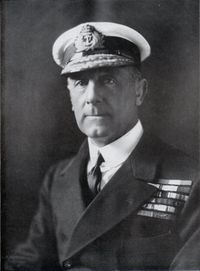Jellicoe:Flag Rank and Controller: Difference between revisions
Simon Harley (talk | contribs) (Made Changes.) |
Simon Harley (talk | contribs) |
||
| Line 2: | Line 2: | ||
==Atlantic Fleet== | ==Atlantic Fleet== | ||
[[File:Albemarle Quebec 1908 PA-024742.jpg|thumb|right|350px|''Albemarle'', wearing Jellicoe's flag at the fore, in Quebec for the Tercentenary in July, 1908.<br><small>Library and Archives Canada.</small>]] | |||
On 25 August Jellicoe was appointed Rear-Admiral (Second-in-Command) of the [[Atlantic Fleet (Royal Navy)|Atlantic Fleet]], Vice-Admiral [[Assheton Gore Curzon-Howe|The Honourable Assheton G. Curzon-Howe]], hoisting his flag in {{UK-Albemarle}} on 26 August.<ref>ADM 196/38. f. 693.</ref> On the 28th he wrote to the First Lord, Tweedmouth, that "I look forward to a most interesting year in this Fleet."<ref>Letter of 28 August, 1907. Tweedmouth Papers. National Museum of the Royal Navy, Portsmouth. MSS 254/634.</ref> | On 25 August Jellicoe was appointed Rear-Admiral (Second-in-Command) of the [[Atlantic Fleet (Royal Navy)|Atlantic Fleet]], Vice-Admiral [[Assheton Gore Curzon-Howe|The Honourable Assheton G. Curzon-Howe]], hoisting his flag in {{UK-Albemarle}} on 26 August.<ref>ADM 196/38. f. 693.</ref> On the 28th he wrote to the First Lord, Tweedmouth, that "I look forward to a most interesting year in this Fleet."<ref>Letter of 28 August, 1907. Tweedmouth Papers. National Museum of the Royal Navy, Portsmouth. MSS 254/634.</ref> | ||
Revision as of 12:24, 24 February 2014
| ||||||||
Atlantic Fleet
On 25 August Jellicoe was appointed Rear-Admiral (Second-in-Command) of the Atlantic Fleet, Vice-Admiral The Honourable Assheton G. Curzon-Howe, hoisting his flag in Albemarle on 26 August.[1] On the 28th he wrote to the First Lord, Tweedmouth, that "I look forward to a most interesting year in this Fleet."[2]
Controller
On 16 October Jellicoe was appointed Third Sea Lord and Controller of the Navy in succession to Sir Henry Jackson.[3]
Jellicoe later wrote:
In order to determine the effectiveness against armoured ships of the shell supplied for the various guns I arranged for extensive firing trials to be carried out in 1910 against the old battleship Edinburgh, which had been specially prepared by the addition of modern armour plates. As a result of these trials, before the end of my term of office as Controller, the Ordnance Board were asked in October 1910 to endeavour to produce an armour piercing shell which would perforate armour at oblique impact and go on in a fit state for bursting. The minute of the D.N.O. on the subject and the Ordnance Board reply were as follows: -
| PROCEEDINGS OF THE ORDNANCE BOARD - October 28th, 1910. | ||
| Minute No.3284. | ||
| D.N.O. 18.10.10. states that the trials recommended by the Board are approved. | Ordnance Board reply. | |
| He asks them to consider the possibility of increasing the chance of A.P. shell carrying their burster through armour plates when striking obliquely by increasing the thickness of the walls of the shells, or by carrying out trials with shell of various shaped cavities, i.e. ribbed, which may be stronger than the cylindrical cavities, observing that the introduction of lyddite seems to render this question more feasible than formerly. | Ask C.S.O.F. [Chief Superintendent of Ordnance Factories] to consider the D.N.O.'s proposals, and the favour the Board with his remarks.[4] | |
Footnotes
Bibliography

